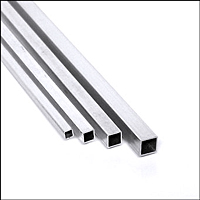| Items |

6061-T6ST-750-125
Aluminum Square Tubing - Series 6061-T6
|

6061-T6ST-1000-125
Aluminum Square Tubing - Series 6061-T6
|

6061-T6ST-1250-125
Aluminum Square Tubing - Series 6061-T6
|

6061-T6ST-1500-062
Aluminum Square Tubing - Series 6061-T6
|

6061-T6ST-1500-125
Aluminum Square Tubing - Series 6061-T6
|
|
Material
|
N/A
Aluminum
|
|
Shapeform
|
N/A
Square Tubing
|
|
Series
|
N/A
6061-T6
|
|
Grade
|
N/A
6061
|
|
Temper
|
N/A
T6
|
|
Size
|
N/A
0.750 x 0.125 inches19.05 x 3.175 mm
|
N/A
1.000 x 0.125 inches25.4 x 3.175 mm
|
N/A
1.250 x 0.125 inches31.75 x 3.175 mm
|
N/A
1.500 x 0.062 inches38.1 x 1.5748 mm
|
N/A
1.500 x 0.125 inches38.1 x 3.175 mm
|
|
Width
|
N/A
0.750 inches
|
N/A
1 inches
|
N/A
1.25 inches
|
N/A
1.5 inches
|
N/A
1.5 inches
|
|
Length
|
N/A
0.125 inches
|
N/A
0.125 inches
|
N/A
0.125 inches
|
N/A
0.062 inches
|
N/A
0.125 inches
|
|
Estimated Weight
|
N/A
0.3675 lbs/ft0.54690027 kg/m
|
N/A
0.5145 lbs/ft0.765660378 kg/m
|
N/A
0.6615 lbs/ft0.984420486 kg/m
|
N/A
0.4194 lbs/ft0.6241359816 kg/m
|
N/A
0.8085 lbs/ft1.203180594 kg/m
|
|
Estimated Weight 24'
|
N/A
8.82 lbs4.000752 kg
|
N/A
12.348 lbs5.6010528 kg
|
N/A
15.876 lbs7.2013536 kg
|
N/A
10.066 lbs4.5659376 kg
|
N/A
19.404 lbs8.8016544 kg
|
|
ASTM Specification
|
N/A
AMS-QQ-A-200/8
|
|
Stock Length
|
N/A
24 ft
|
|
Ultimate Strength
|
N/A
45 ksi
|
|
Yield Strength
|
N/A
40 ksi
|
|
Elongation percent in 2 inches
|
N/A
12
|
|
Hardness Brinnel Number
|
N/A
95
|
|
Ultimate Shearing Strength
|
N/A
30 ksi
|
|
Fatigue Endurance Limit1
|
N/A
14 ksi
|
|
Modulus of Elasticity2
|
N/A
10.0 x 103 ksi
|
|
Resistance to Corrosion - General3
|
N/A
B
|
|
Stress Corrosion Cracking
|
N/A
A
|
|
Workability (Cold)
|
N/A
C
|
|
Mechinability
|
N/A
C
|
|
Brazeability4
|
N/A
A
|
|
Gas Weldability5
|
N/A
A
|
|
Arc Weldability6
|
N/A
A
|
|
Resistance Spot and Seam Weldability7
|
N/A
A
|
|
Applications
|
N/A
Heavy-duty structures requiring good corrosion resistance, truck and marine, railroad cars, furniture, pipelines
|
|
Density
|
N/A
0.098 lbs/in³
|
|
Specific Gravity
|
N/A
2.70
|


